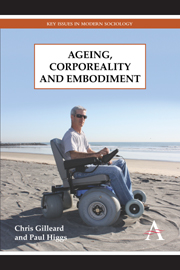Book contents
- Frontmatter
- Contents
- Introduction
- Chapter 1 Identity, Embodiment and the Somatic Turn in the Social Sciences
- Chapter 2 Corporeality, Embodiment and the ‘New Ageing’
- Chapter 3 Gender, Ageing and Embodiment
- Chapter 4 Age and the Racialised Body
- Chapter 5 Disability, Ageing and Identity
- Chapter 6 Sexuality, Ageing and Identity
- Chapter 7 Sex and Ageing
- Chapter 8 Cosmetics, Clothing and Fashionable Ageing
- Chapter 9 Fitness, Exercise and the Ageing Body
- Chapter 10 Ageing and Aspirational Medicine
- Conclusions: Ageing, Forever Embodied
- References
- Index
- ADVANCE PRAISE
Chapter 3 - Gender, Ageing and Embodiment
Published online by Cambridge University Press: 05 July 2013
- Frontmatter
- Contents
- Introduction
- Chapter 1 Identity, Embodiment and the Somatic Turn in the Social Sciences
- Chapter 2 Corporeality, Embodiment and the ‘New Ageing’
- Chapter 3 Gender, Ageing and Embodiment
- Chapter 4 Age and the Racialised Body
- Chapter 5 Disability, Ageing and Identity
- Chapter 6 Sexuality, Ageing and Identity
- Chapter 7 Sex and Ageing
- Chapter 8 Cosmetics, Clothing and Fashionable Ageing
- Chapter 9 Fitness, Exercise and the Ageing Body
- Chapter 10 Ageing and Aspirational Medicine
- Conclusions: Ageing, Forever Embodied
- References
- Index
- ADVANCE PRAISE
Summary
We begin our exploration of corporeality, embodiment and ageing with the issue of gender. We have chosen to start with this topic for two reasons. First, because the transformation of the terms ‘sex’ and ‘sexual difference’ into the more socially oriented term ‘gender’ served as a major vector through which the body emerged as a source and signifier of socially constituted forms of ‘difference’; and second, because gender provides one of the most important vehicles through which the embodiment of ageing can be examined. The 1960s' sexual revolution involved a ‘rejection of the biological determinism implicit in the use of such terms as “sex” or “sexual difference”’ (Scott 1986, 1054). In their place, the growing use of the term ‘gender’ directed attention away from the individual, isolated body to the relational distinction between men and women, while also reflecting the social organisation of both sexuality and gender. The transformation of sex from a biological category into gender as a sociological identity led to a rethinking of the distinction between bodies as corporeal entities and bodies as social identities. In short it allowed for thinking about and thinking through the body differently. The ‘second wave’ feminist writers who emerged during the 1960s initiated this shift in approach which has since been incorporated into the new ‘sociology of the body’ and which is now beginning to impact upon the ‘new ageing’.
- Type
- Chapter
- Information
- Ageing, Corporeality and Embodiment , pp. 33 - 50Publisher: Anthem PressPrint publication year: 2013



